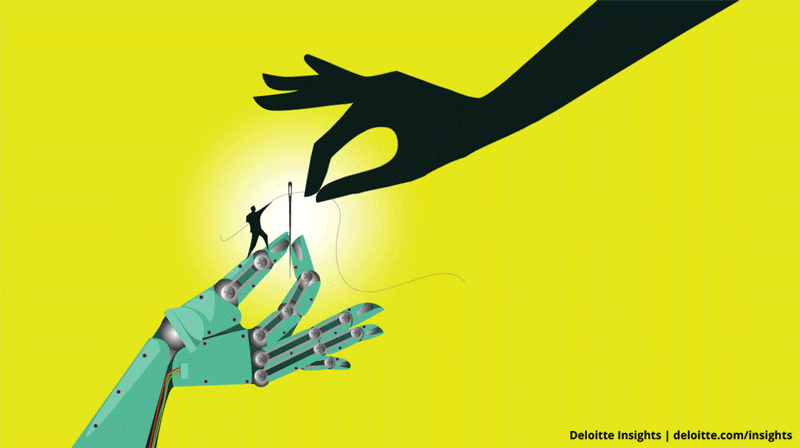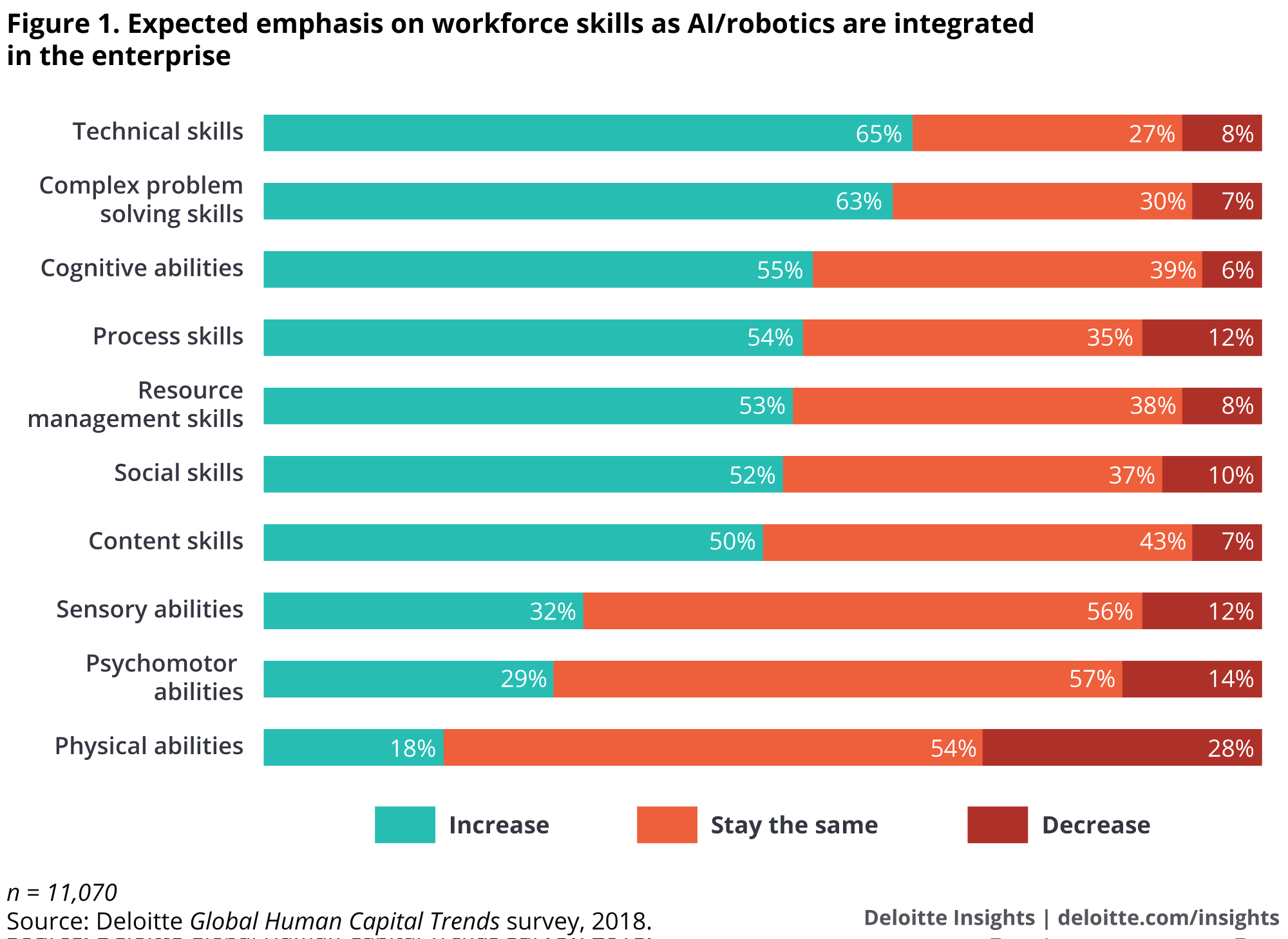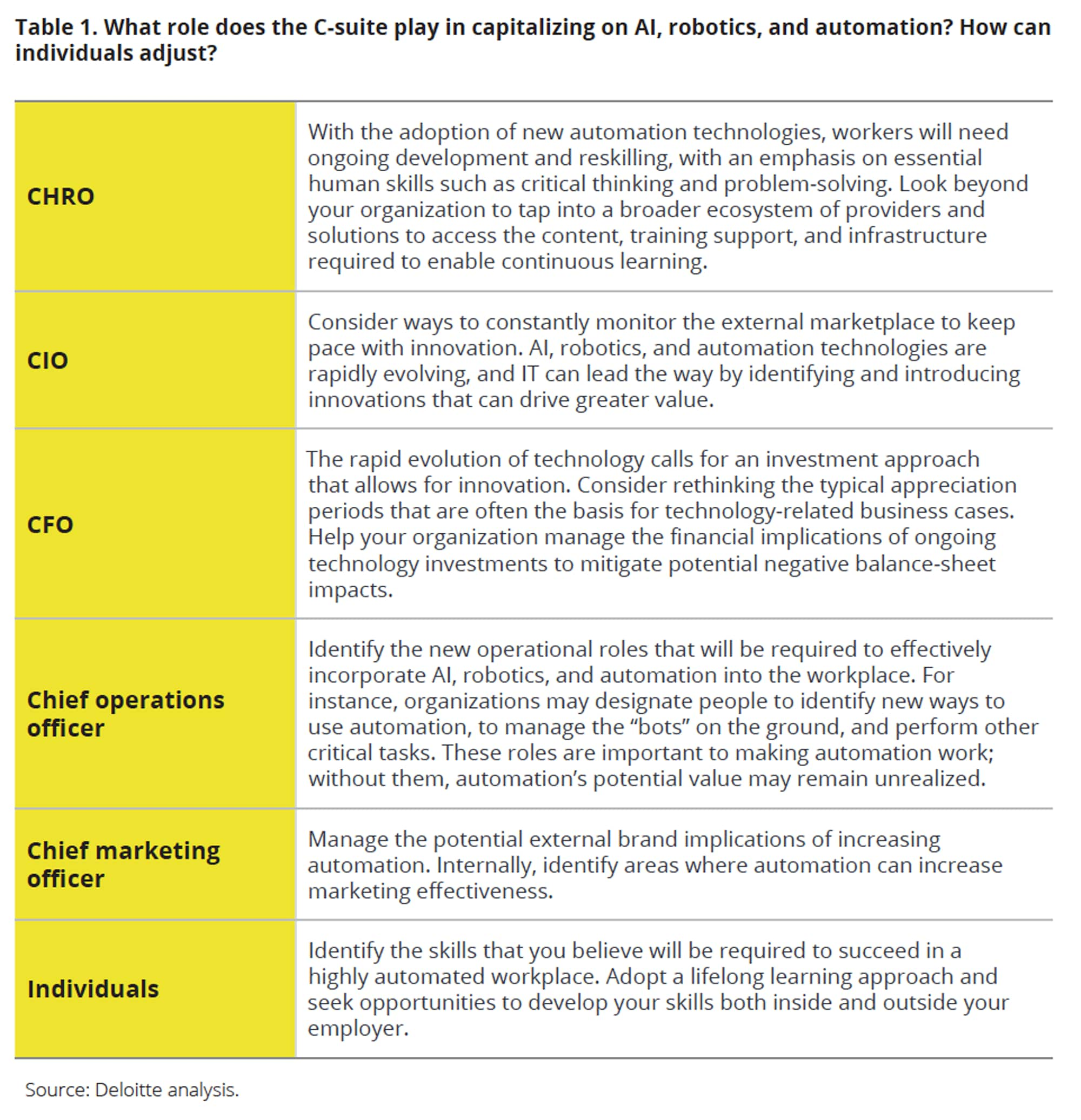
AI, robotics, and automation: Put humans in the loop 2018 Global Human Capital Trends
29 March 2018
As AI and other advanced technologies permeate the workplace, skills such as critical thinking, creativity, and problem-solving gain in importance. Leading companies are recognizing that these technologies are most effective when they complement humans, not replace them.

Rethinking the nature of work
Learn more
View 2018 Global Human Capital Trends
Explore the infographic and watch the video
Explore the insights from Deloitte’s State of AI in the Enterprise, 2nd Edition survey
Download the full report or create a custom PDF
Learn how companies are redefining work
AI, robotics, and automation have gained a rapidly expanding foothold in the workplace, faster than many organizations ever expected. While organizations are increasingly using these technologies to automate existing processes, true pioneers are radically rethinking work architecture to maximize the value of both humans and machines—creating new opportunities to organize work more effectively and to redefine the human workforce’s skills and careers.
The adoption of automation, robotics, and artificial intelligence (AI) is accelerating dramatically. Forty-one percent of respondents to this year’s survey rate this topic as very important. Almost half (47 percent) of this year’s respondents say that their organizations are deeply involved in automation projects, with 24 percent using AI and robotics to perform routine tasks, 16 percent to augment human skills, and 7 percent to restructure work entirely.
Expectations for AI and robotics have also increased significantly. This year, 42 percent of the respondents we surveyed believe that AI will be widely deployed at their organizations within three to five years—up from 38 percent last year. But despite these expectations, many organizations may still be coming to grips with AI’s potential uses. Indeed, a 2017 survey of 1,500 senior executives found that only 17 percent of them were familiar with both the concept of AI and its applications at their companies.1 This finding is consistent with our own results: Our analysis of the “readiness gap” for this issue shows that, while 72 percent of our respondents see this area as important, only 31 percent feel ready to address it.
Accelerating experimentation, shifting to implementation
As more organizations rush to embrace these technologies, the marketplace for AI tools and robotics is booming. Leading companies such as Microsoft, IBM, Facebook, and other technology giants are heavily investing in this area. At the same time, analysts believe that more than $6 billion has been pumped into over 1,000 AI start-ups in the last three years, in industries ranging from transportation to health care, and across a range of specialties—including HR.2
Organizations outside the tech world are also forging ahead with implementation. Coca-Cola used AI analysis of data from self-service soda fountains to help make the decision to launch Cherry Sprite.3 Morgan Stanley equipped 16,000 financial advisers with machine learning algorithms that automate rote tasks, freeing up advisers to focus on client service.4 In health care, AI and robotics are speeding up patient service, improving medical record-keeping, and monitoring employee well-being.5 Overall, AI tools are projected to create nearly $3 trillion in business value by 2021.6
AI and robotics open exciting new capabilities for HR. Software can now recognize faces and identify gender,7 listen to voices and identify mood,8 and decode video interviews to identify education level, lying, and cognitive ability.9 Analytics tools are intelligently selecting candidates,10 identifying employees’ career options,11 and coaching managers on improving their leadership skills.12 And the potential doesn’t end there: AI is even being used to create chatbots that can interact with job candidates, identify and score video interviews, and understand the sentiment of engagement surveys. Every major human capital management cloud provider is now implementing algorithms, making it important for organizations to maintain accurate data and carefully review these tools for accuracy and potential bias.
AI and people are smarter together
Leading companies increasingly recognize that these technologies are most effective when they complement humans, not replace them. Amazon now has 100,000 robots in operation,13 which has shortened training for holiday workers to less than two days.14 Walmart recently deployed virtual reality technology to improve its in-store training and effectively simulate customer environments.15 Manufacturers such as Airbus and Nissan are finding ways to use collaborative robots, or “co-bots,” that work side by side with workers in factories.16
There is also growing recognition that AI tools require human oversight. Behind the scenes, major tech firms have tens of thousands of humans continuously watching, training, and improving their algorithms.17 As the CEO of CrowdFlower—a start-up that provides algorithm trainers—puts it, an algorithm is only as effective as “the quantity and quality of the training data to get [it] going.”18 This realization has given rise to new jobs with titles such as “bot trainer,” “bot farmer,” and “bot curator.”
In the HR technology domain, vendors of recruitment chatbots such as Textrecruit’s Ari, Hiremya.com’s Mya, and Paradox.ai’s Olivia display the growing adoption of natural language processing. The hard part is often not decoding human language but training the software to ask the right questions, provide the right answers, and avoid alienating the job candidate. One vendor says it has taken over a year to train its chatbot to intelligently screen hourly job candidates.
The need for human involvement complicates the widely held view that AI will automate everything. If anything, humans and their innate skills seem to be growing more important as the need to devise, implement, and validate AI solutions becomes widespread. Understanding the unique capabilities that machines and humans bring to different types of work and tasks will be critical as the focus moves from automation to the redesign of work.
Moving from job redesign to work architecture
Research suggests that while automation can improve scale, speed, and quality, it does not do away with jobs. In fact, it might do just the opposite. As Boston University professor James Bessen has reported in his research, occupations with greater levels of computerization and technology experience higher, not lower, employment growth rates.19 What’s more, in many cases, the newly created jobs are more service-oriented, interpretive, and social, playing to the essential human skills of creativity, empathy, communication, and complex problem-solving. Sales professionals, for instance, can leverage AI tools such as Salesforce, Einstein, and others so they themselves can focus on human interaction, and health care workers can use intelligent machines to free up time to communicate with patients.
Indeed, despite the surge of interest in AI and automation, respondents to this year’s Global Human Capital Trends survey predict tremendous future demand for human skills such as complex problem-solving (63 percent), cognitive abilities (55 percent), social skills (52 percent), and process skills (54 percent). While 65 percent also predict strong demand for technical skills, research shows that the technical skills to create, install, and maintain machines account for only a small fraction of the workforce.20 Reinforcing this view, a recent World Economic Forum study found that the top 10 skills for the next decade include essential human skills such as critical thinking, creativity, and people management.21
What human skills are needed to use AI effectively?
Respondents have a clear understanding of the human skills needed to manage AI, robotics, and automation, such as complex problem-solving, cognitive abilities, and social skills. Yet many also said they do not have a plan to cultivate these skills.

Explore the data further in the Global Human Capital Trends app.
The irony here is that most companies are struggling to recruit and develop these human skills of the future. Despite having an increasingly clear understanding of the skills needed in a world where humans work side by side with machines, 49 percent of our respondents told us they do not have a plan to cultivate them. We see this as an urgent human capital challenge requiring top executive support to transform organizational structures, cultures, career options, and performance management practices.
Rather than replacing humans outright, the introduction of new machines changes the skills and requirements the workforce needs to be able to take advantage of the new technologies. The greatest opportunity this may present is not just to redesign jobs, but to fundamentally rethink “work architecture.” Doing this involves decomposing work into its fundamental components—for instance, assessment, production, problem-solving, communication, supervision—and analyzing ways that new combinations of machines and humans working together can accomplish them, with each party bringing unique strengths to the task. Absent a thoughtful approach, organizations may not only risk failing to identify the skills they need to take effective advantage of technology, but also suffer damage to their employee and corporate brand due to perceptions around (real or supposed) workforce reductions.
Over the next several years, one of HR and business leaders’ greatest challenges will be to redesign many of today’s work and workforce configurations. This will require them to ask fundamental questions about which work tasks and activities can be automated, what technologies to use, and what combinations of people and smart machines can effectively do the work.22 A renewed, imaginative focus on workforce development, learning, and career models will be important. Perhaps most critical of all, however, will be the need to create meaningful work—work that, notwithstanding their new collaboration with intelligent machines, human beings will be eager to embrace.
The bottom line
In 2018 and beyond, we expect continuing rapid adoption and maturation of AI, robotics, and automation solutions. Leading organizations are working hard to put humans in the loop—rethinking work architecture, retraining people, and rearranging the organization to leverage technology to transform business. The broader aim is not just to eliminate routine tasks and cut costs, but to create value for customers and meaningful work for people.






